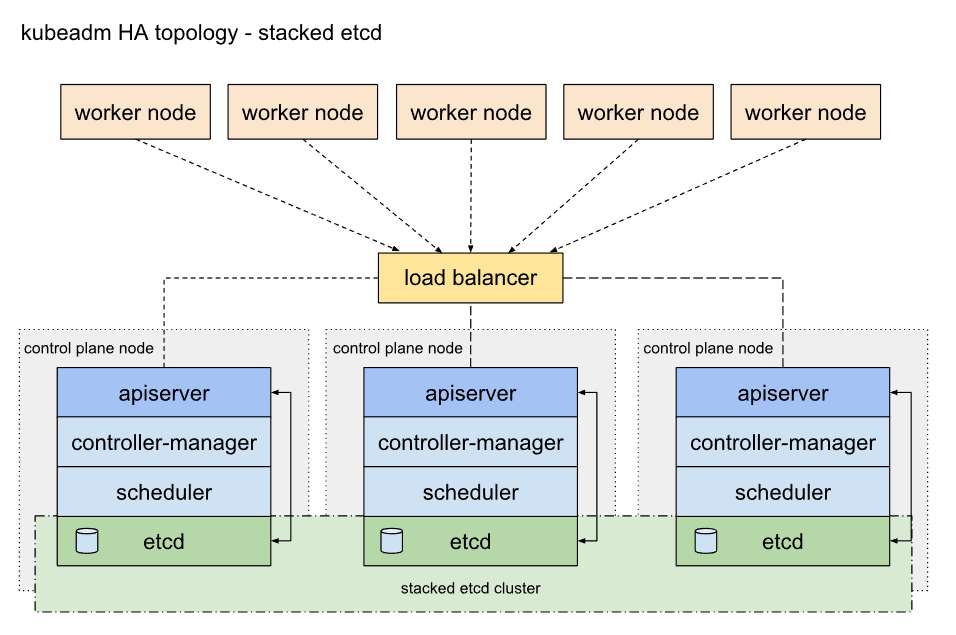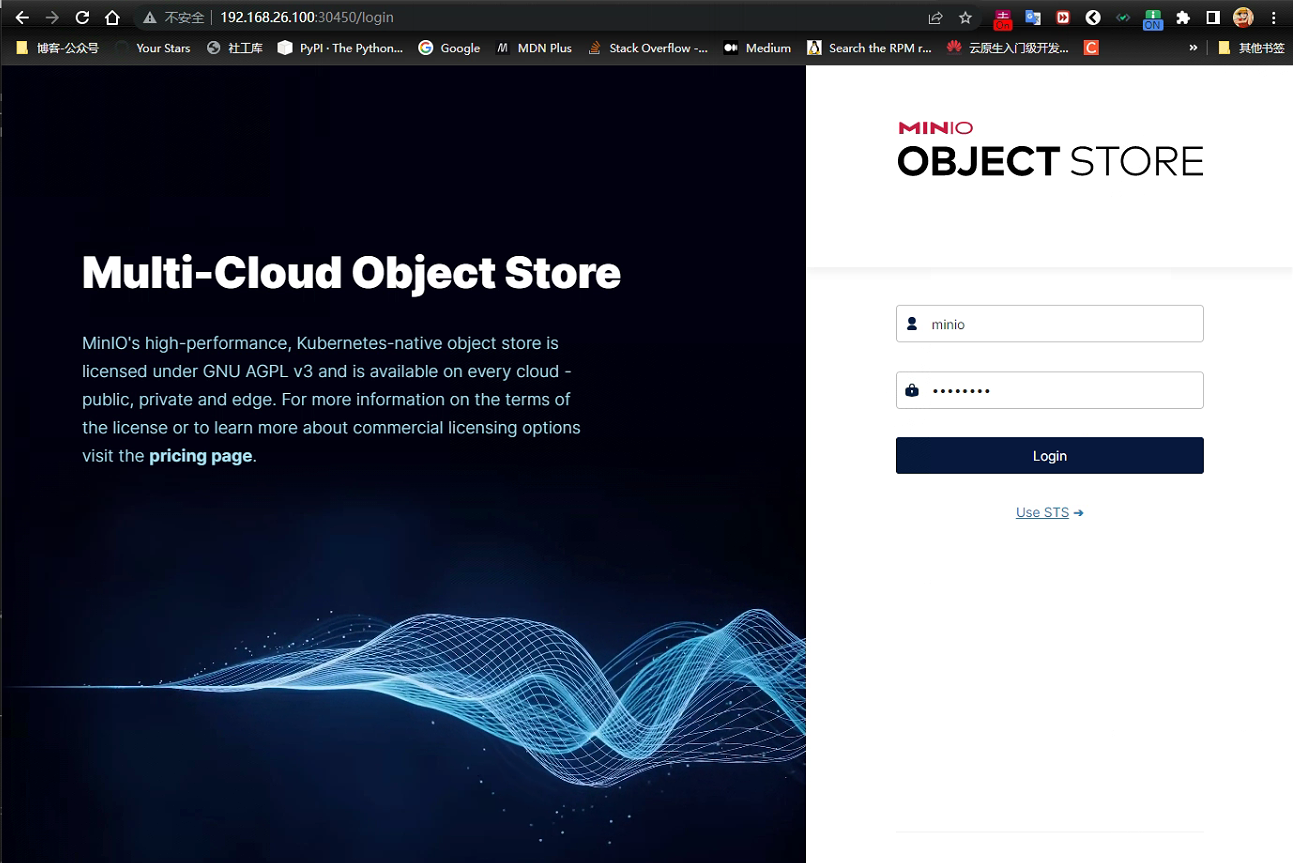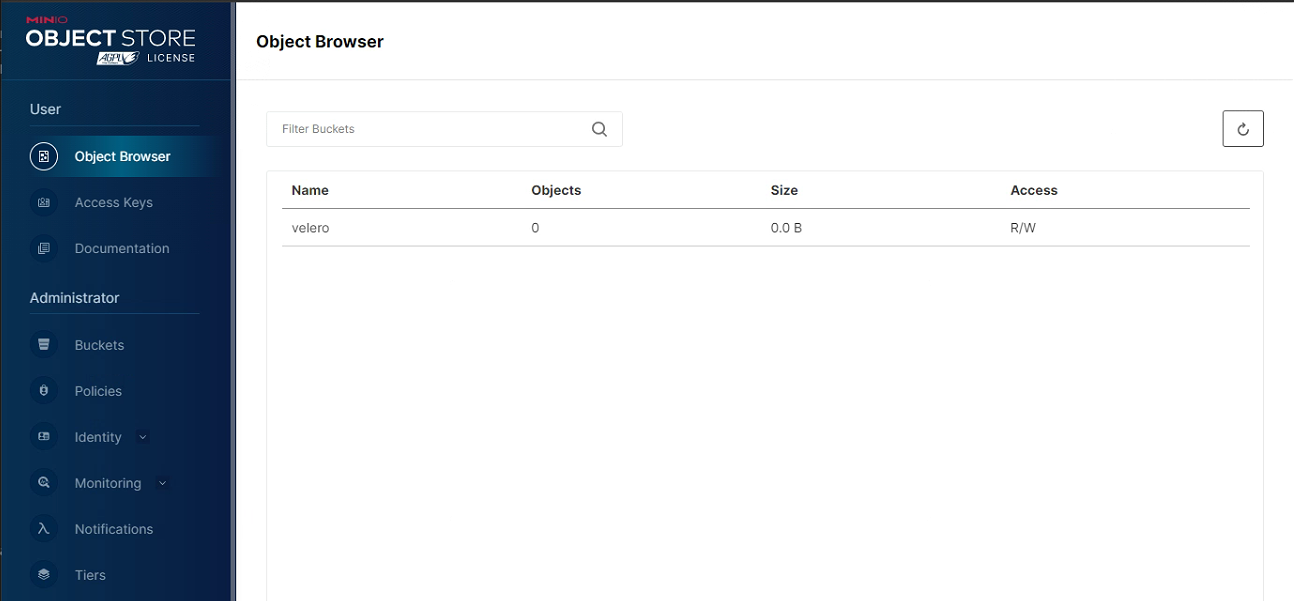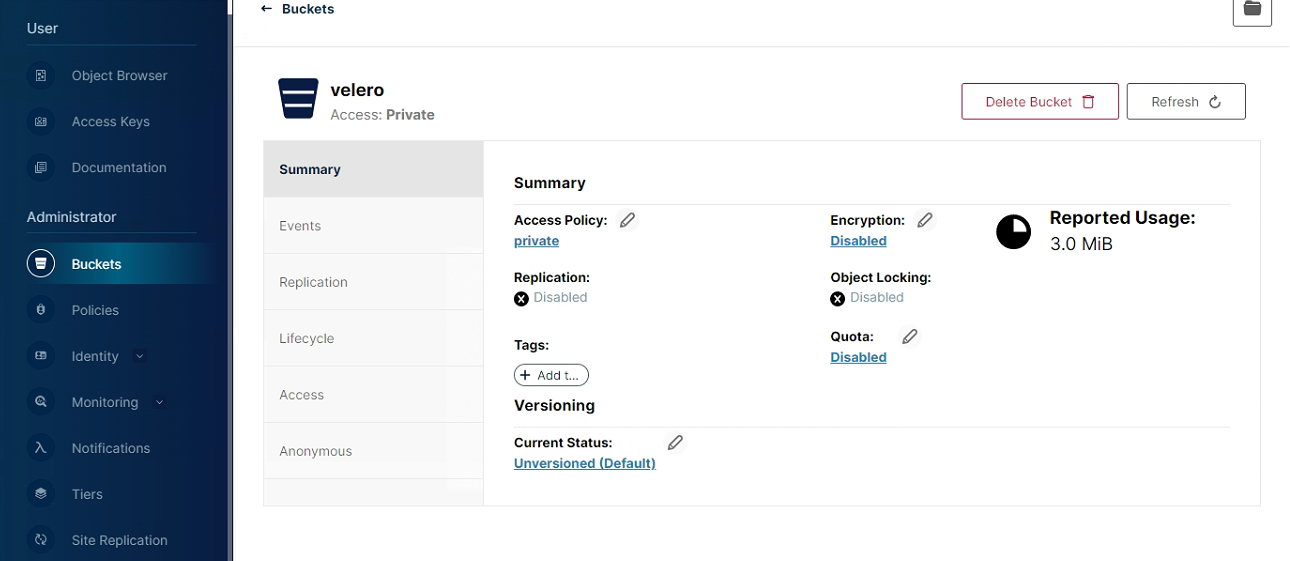我所渴求的,無非是將心中脫穎語出的本性付諸生活,為何竟如此艱難呢 ——赫尔曼·黑塞《德米安》
写在前面
分享一个 k8s 高可用集群部署的 Ansible 剧本
以及涉及到的一些工具的安装
博文内容涉及:
从零开始 一个 k8s 高可用 集群部署 Ansible剧本编写,
编写后搭建 k8s 高可用 集群
一些集群常用的 监控,备份工具安装,包括:
cadvisor 监控工具部署metrics-server 监控工具部署Ingress—nginx Ingress 控制器部署Metallb 软 LoadBalancer 部署local-path-storage 基于本地存储的SC 分配器部署prometheus 监控工具部署ETCD 快照备份定时任务编写运行Velero 集群容灾备份工具部署
理解不足小伙伴帮忙指正
我所渴求的,無非是將心中脫穎語出的本性付諸生活,為何竟如此艱難呢 ——赫尔曼·黑塞《德米安》
部署完的 集群 node 信息查看,感觉版本有点高,生产不太建议安装这么高的版本,有些开源工具都安装不了,各种问问题…
1 2 3 4 5 6 7 8 9 10 11 ┌──[root@vms100.liruilongs.github.io]-[~/ansible] └─$kubectl get nodes NAME STATUS ROLES AGE VERSION vms100.liruilongs.github.io Ready control-plane 10d v1.25.1 vms101.liruilongs.github.io Ready control-plane 10d v1.25.1 vms102.liruilongs.github.io Ready control-plane 10d v1.25.1 vms103.liruilongs.github.io Ready <none> 10d v1.25.1 vms105.liruilongs.github.io Ready <none> 10d v1.25.1 vms106.liruilongs.github.io Ready <none> 10d v1.25.1 vms107.liruilongs.github.io Ready <none> 10d v1.25.1 vms108.liruilongs.github.io Ready <none> 10d v1.25.1
部署涉及机器
master1: 192.168.26.100
master2: 192.168.26.101
master3: 192.168.26.102
work Node1: 192.168.26.103
work Node2: 192.168.26.105
work Node3: 192.168.26.106
work Node4: 192.168.26.107
work Node5: 192.168.26.108
哈 104 不吉利,跳过去了…..
集群部署 部署拓扑 下图为 k8s 官网文档中 HA 拓扑图,这里使用下面的拓扑方式部署
堆叠(Stacked)HA 集群拓扑, 其中 etcd 分布式数据存储集群堆叠在 kubeadm 管理的控制平面节点上,作为控制平面的一个组件运行。
部署后的 etcd 分布
1 2 3 4 5 6 7 8 9 10 ┌──[root@vms100.liruilongs.github.io]-[~/ansible/kubescape] └─$ETCDCTL_API =3 etcdctl --endpoints https://127.0.0.1:2379 --cert="/etc/kubernetes/pki/etcd/server.crt" --key="/etc/kubernetes/pki/etcd/server.key" --cacert="/etc/kubernetes/pki/etcd/ca.crt" member list - w table +------------------+---------+-----------------------------+-----------------------------+-----------------------------+ | ID | STATUS | NAME | PEER ADDRS | CLIENT ADDRS | +------------------+---------+-----------------------------+-----------------------------+-----------------------------+ | ee392e5273e89e2 | started | vms100.liruilongs.github.io | https://192.168.26.100:2380 | https://192.168.26.100:2379 | | 11486647d7f3a17b | started | vms102.liruilongs.github.io | https://192.168.26.102:2380 | https://192.168.26.102:2379 | | e00e3877df8f76f4 | started | vms101.liruilongs.github.io | https://192.168.26.101:2380 | https://192.168.26.101:2379 | +------------------+---------+-----------------------------+-----------------------------+-----------------------------+
每个控制平面节点运行 kube-apiserver、kube-scheduler 和 kube-controller-manager 实例。 kube-apiserver 使用负载均衡器暴露给工作节点。
每个控制平面节点创建一个本地 etcd 成员(member),这个 etcd 成员只与该节点的 kube-apiserver 通信。 这同样适用于本地 kube-controller-manager 和 kube-scheduler 实例。
这种拓扑将控制平面和 etcd 成员耦合在同一节点上。相对使用外部 etcd 集群, 设置起来更简单,而且更易于副本管理。
然而,堆叠集群存在耦合失败的风险。如果一个节点发生故障,则 etcd 成员和控制平面实例都将丢失, 并且冗余会受到影响。你可以通过添加更多控制平面节点来降低此风险。
因此,你应该为 HA 集群运行至少三个堆叠的控制平面节点。
1 2 3 4 5 6 7 8 9 10 11 ┌──[root@vms100.liruilongs.github.io]-[~/ansible/kubescape] └─$ETCDCTL_API =3 etcdctl --endpoints https://127.0.0.1:2379 --cert="/etc/kubernetes/pki/etcd/server.crt" --key="/etc/kubernetes/pki/etcd/server.key" --cacert="/etc/kubernetes/pki/etcd/ca.crt" endpoint status --cluster -w table +-----------------------------+------------------+---------+---------+-----------+-----------+------------+ | ENDPOINT | ID | VERSION | DB SIZE | IS LEADER | RAFT TERM | RAFT INDEX | +-----------------------------+------------------+---------+---------+-----------+-----------+------------+ | https://192.168.26.100:2379 | ee392e5273e89e2 | 3.5.4 | 37 MB | false | 100 | 3152364 | | https://192.168.26.102:2379 | 11486647d7f3a17b | 3.5.4 | 36 MB | false | 100 | 3152364 | | https://192.168.26.101:2379 | e00e3877df8f76f4 | 3.5.4 | 36 MB | true | 100 | 3152364 | +-----------------------------+------------------+---------+---------+-----------+-----------+------------+ ┌──[root@vms100.liruilongs.github.io]-[~/ansible/kubescape] └─$
当使用 kubeadm init 和 kubeadm join –control-plane 时, 在控制平面节点上会自动创建本地 etcd 成员。ETCD 一点要定期备份
部署中涉及太多文件,篇幅问题,文件无法展示,以上传 git 仓库,获取 git 仓库地址方式,关注 公总好 山河已无恙 ,回复 k8s-ha-deploy 即可获得地址。
免密配置 这里假设我们拿到的是安装了系统的新机。这里我的机器,通过 克隆的的生成的 虚机,所以配置了 YUM 源,如果没有,需要先配置一台虚机,剩下的通过 Ansible 的批量配置下 YUM ,所以对应 YUM 的配置这个教程没有涉及,YUM 主要配置为 阿里云的 就可以。配置文件小伙伴可以通过 git 获取。
在安装 Ansible 之前,方便操作,我们需要批量配置下免密,这个使用 expect 的方式实现,用直接写好了 脚本直接执行,需要配置的主机 单独列出读取。
安装 expect
1 2 ┌──[root@vms100.liruilongs.github.io]-[~] └─$yum -y install expect
列出部署主机
1 2 3 4 5 6 7 8 9 10 ┌──[root@vms100.liruilongs.github.io]-[~] └─$cat host_list 192.168.26.100 192.168.26.101 192.168.26.102 192.168.26.103 192.168.26.105 192.168.26.106 192.168.26.107 192.168.26.108
免密脚本,直接执行即可,如果主机清单文件名相同,直接读取即可
1 2 3 4 5 6 7 8 9 10 11 12 13 14 15 16 17 18 19 20 21 22 23 24 25 26 27 28 29 30 31 32 33 34 35 36 37 38 39 40 41 42 43 44 45 46 47 48 49 50 51 52 53 #!/bin/bash /usr/bin/expect <<-EOF spawn ssh-keygen expect "(/root/.ssh/id_rsa)" {send "\r"} expect { "(empty for no passphrase)" {send "\r"} "already" {send "y\r"} } expect { "again" {send "\r"} "(empty for no passphrase)" {send "\r"} } expect { "again" {send "\r"} "#" {send "\r"} } expect "#" expect eof EOF for IP in $( cat host_list )do if [ -n IP ];then /usr/bin/expect <<-EOF spawn ssh-copy-id root@$IP expect { "*yes/no*" { send "yes\r"} "*password*" { send "redhat\r" } } expect { "*password" { send "redhat\r"} "#" { send "\r"} } expect "#" expect eof EOF fi done
OK,配置完免密之后,需要安装 Ansible, 运维工具,一定要装一个,机器太多了很费人。
Ansible 安装 1 2 ┌──[root@vms100.liruilongs.github.io]-[~] └─$yum -y install ansible
ansible 配置 这里的主机清单,随便配置一个无效的,建议不要在配置文件中配置正确的主机清单,防止执行剧本到错误的主机节点。
1 2 3 4 5 6 7 8 9 10 11 12 13 14 15 16 17 ┌──[root@vms100.liruilongs.github.io]-[~/ansible] └─$vim ansible.cfg ┌──[root@vms100.liruilongs.github.io]-[~/ansible] └─$cat ansible.cfg [defaults] inventory=inventory remote_user=root roles_path=roles [privilege_escalation] become=True become_method=sudo become_user=root become_ask_pass=False
拷贝前面的文件测试下网络情况
1 2 3 4 5 6 7 8 9 10 ┌──[root@vms100.liruilongs.github.io]-[~/ansible] └─$cat host_list 192.168.26.100 192.168.26.101 192.168.26.102 192.168.26.103 192.168.26.105 192.168.26.106 192.168.26.107 192.168.26.108
1 2 ┌──[root@vms100.liruilongs.github.io]-[~/ansible] └─$ansible all -m ping -i host_list
测试没问题,需要编写下 主机清单文件
1 2 3 4 5 6 7 8 9 10 11 12 13 14 15 16 17 18 19 20 ┌──[root@vms100.liruilongs.github.io]-[~/ansible] └─$cat host.yaml ansible: children: ansible_master: hosts: 192.168.26.100: ansible_node: hosts: 192.168 .26 .[101:103]: 192.168 .26 .[105:108]: k8s: children: k8s_master: hosts: 192.168 .26 .[100:102]: k8s_node: hosts: 192.168.26.103: 192.168 .26 .[105:108]:
检查清单文件,这里的分组就不多讲了。
1 2 3 4 5 6 7 8 9 10 11 12 13 14 15 16 17 18 19 20 21 22 23 24 25 26 ┌──[root@vms100.liruilongs.github.io]-[~/ansible] └─$ansible -inventory -i host.yaml --graph @all: |--@ansible: | |--@ansible_master: | | |--192.168.26.100 | |--@ansible_node: | | |--192.168.26.101 | | |--192.168.26.102 | | |--192.168.26.103 | | |--192.168.26.105 | | |--192.168.26.106 | | |--192.168.26.107 | | |--192.168.26.108 |--@k8s: | |--@k8s_master: | | |--192.168.26.100 | | |--192.168.26.101 | | |--192.168.26.102 | |--@k8s_node: | | |--192.168.26.103 | | |--192.168.26.105 | | |--192.168.26.106 | | |--192.168.26.107 | | |--192.168.26.108 |--@ungrouped:
测试一下清单文件
1 2 3 4 5 6 7 8 9 10 11 ┌──[root@vms100.liruilongs.github.io]-[~/ansible] └─$ansible all --list-hosts -i host.yaml hosts (8): 192.168.26.100 192.168.26.101 192.168.26.102 192.168.26.103 192.168.26.105 192.168.26.106 192.168.26.107 192.168.26.108
为了使用 tab 键,这里我们建一些清单组的空文件。
1 2 3 4 5 6 7 8 ┌──[root@vms100.liruilongs.github.io]-[~/ansible] └─$touch ansible_master ansible_node k8s_master k8s_node ┌──[root@vms100.liruilongs.github.io]-[~/ansible] └─$ls ansible.cfg ansible_node host_list_no_ansible k8s_master ps1_mod.yaml ansible_master host_list host.yaml k8s_node ┌──[root@vms100.liruilongs.github.io]-[~/ansible] └─$
为了方便演示,看到当前的执行目录,配置下 PS1
1 2 3 4 5 6 7 8 9 10 11 ┌──[root@vms100.liruilongs.github.io]-[~/ansible] └─$cat ps1_mod.yaml --- - name: all modify PS1 hosts: ansible_node tasks: - name: PS1 modify shell: echo 'PS1="\[\033[1;32m\]┌──[\[\033[1;34m\]\u@\H\[\033[1;32m\]]-[\[\033[0;1m\]\w\[\033[1;32m\]] \n\[\033[1;32m\]└─\[\033[1;34m\]\$\[\033[0m\]"' >> /root/.bashrc - name: PS1 disply shell: cat /root/.bashrc | grep PS1
执行剧本并测试。
1 2 ┌──[root@vms100.liruilongs.github.io]-[~/ansible] └─$ansible -playbook ps1_mod.yaml -i host.yaml -vv
k8s 安装前环境准备 检查机器 UUID 和 网卡MAC 地址 1 2 3 4 ┌──[root@vms100.liruilongs.github.io]-[~/ansible] └─$ansible k8s -m shell -a "ip link | grep ether| awk '{print $2 }' " -i host.yaml ┌──[root@vms100.liruilongs.github.io]-[~/ansible] └─$ansible k8s -m shell -a "cat /sys/class/dmi/id/product_uuid " -i host.yaml
剩下的 操作这个编写一个 k8s 部署环境的初始化的 剧本任务 k8s_init_deploy.yaml,涉及各项通过剧本任务引用实现
hosts 文件准备 没有 DNS ,如果有 DNS 服务器,则不需要
1 2 3 4 5 6 7 8 9 10 11 12 ┌──[root@vms100.liruilongs.github.io]-[~/ansible/file] └─$cat hosts 127.0.0.1 localhost localhost.localdomain localhost4 localhost4.localdomain4 ::1 localhost localhost.localdomain localhost6 localhost6.localdomain6 192.168.26.100 vms100.liruilongs.github.io vms100 192.168.26.101 vms101.liruilongs.github.io vms101 192.168.26.102 vms102.liruilongs.github.io vms102 192.168.26.103 vms103.liruilongs.github.io vms103 192.168.26.105 vms105.liruilongs.github.io vms105 192.168.26.106 vms106.liruilongs.github.io vms106 192.168.26.107 vms107.liruilongs.github.io vms107 192.168.26.108 vms108.liruilongs.github.io vms108
把 hosts 文件替换为所有机器的 hosts ,编写剧本任务
1 2 3 4 5 6 7 8 9 ┌──[root@vms100.liruilongs.github.io]-[~/ansible] └─$cat k8s_init_deploy.yaml --- - name: copy "/etc/hosts" copy: src: ./file/hosts dest: /etc/hosts force: yes
防火墙,交换分区,SElinux 设置 编写剧本任务,在之前的 初始化剧本补充。
1 2 3 4 5 6 7 8 9 10 11 12 13 14 15 16 17 18 19 20 21 22 23 24 25 26 27 28 29 30 ┌──[root@vms100.liruilongs.github.io]-[~/ansible] └─$cat k8s_init_deploy.yaml --- - name: copy "/etc/hosts" copy: src: ./file/hosts dest: /etc/hosts force: yes - name: firewalld setting trusted firewalld: zone: trusted permanent: yes state: enabled - name: Disable SELinux selinux: state: disabled - name: Disable swapoff shell: /usr/sbin/swapoff -a - name: delete /etc/fstab shell: sed -i '/swap/d' /etc/fstab
这里我们通过 任务引用的方式来执行,并且打一个 init 的标签。方便之后单独执行,引入到当前的 k8s 部署剧本 k8s_deploy.yaml
1 2 3 4 5 6 7 8 9 10 11 12 ┌──[root@vms100.liruilongs.github.io]-[~/ansible] └─$cat k8s_deploy.yaml --- - name: k8s deploy hosts: k8s tasks: - name: init k8s include_tasks: file: k8s_init_deploy.yaml tags: - init_k8s
k8s_deploy.yaml 为部署 k8s 所有操作的剧本。可以先执行下,完成前面的部署工作。
1 2 ┌──[root@vms100.liruilongs.github.io]-[~/ansible] └─$ansible -playbook k8s_deploy.yaml -i host.yaml -f 4
有 8 个 机器,这里的 -f 4 为并行执行的意思。 -i host.yaml 指定主机清单
安装容器运行时 CRI docker 这里选择 Dokcer 作为 CRI ,但是Docker 本身没有实现 CRI,在 k8s 在 1.24 的移除了 docker 和 K8s 的桥梁 Dockershim ,所以不能直接使用,需要安装 cri-docker .
这里需要注意:
部署 cri-docker 要重载沙箱(pause)镜像,cri-dockerd 适配器能够接受指定用作 Pod 的基础容器的容器镜像(“pause 镜像”)作为命令行参数。 要使用的命令行参数是 --pod-infra-container-image。 如果不指定,会直接从 谷歌的镜像库拉取,即使在 kubeadm init 指定了 镜像库也不行(我部署是不行),同时,如果部署 HA ,使用 keepalived + Haproxy 的方式,并且通过 静态 Pod 的方式部署,在 启动 kubelet 的时候 静态pod 也会直接从 谷歌的镜像库拉取。
对应 cgroup 驱动的使用,按照官方官网推荐的来。 如果系统通过 systemd 来引导,就用 systemd
CRI 安装的初始化工作 转发 IPv4 并让 iptables 看到桥接流量, 相关文件准备,需要注意
1 2 3 4 5 6 7 8 9 ┌──[root@vms100.liruilongs.github.io]-[~/ansible/file/modules-load.d] └─$cat k8s.conf overlay br_netfilter ┌──[root@vms100.liruilongs.github.io]-[~/ansible/file/sysctl.d] └─$cat k8s.conf net.bridge.bridge-nf-call-iptables = 1 net.bridge.bridge-nf-call-ip6tables = 1 net.ipv4.ip_forward = 1
docker 配置文件准备,这里的配置项 "data-root": "/docker/data", 为 docker 数据目录,最好找一个大一点的地方。如果修改的话,剧本的创建目录要同步修改。
1 2 3 4 5 6 7 8 9 10 11 12 13 14 15 16 17 18 19 20 21 ┌──[root@vms100.liruilongs.github.io]-[~/ansible] └─$cat file/daemon.json { "exec-opts" : ["native.cgroupdriver=systemd" ], "log-driver" : "json-file" , "data-root" : "/docker/data" , "log-opts" : { "max-size" : "100m" }, "storage-driver" : "overlay2" , "storage-opts" : [ "overlay2.override_kernel_check=true" ], "experimental" : false , "debug" : false , "max-concurrent-downloads" : 10 , "registry-mirrors" : [ "https://2tefyfv7.mirror.aliyuncs.com" , "https://docker.mirrors.ustc.edu.cn" ] }
当前需要复制的配置文件
1 2 3 4 5 6 7 8 9 ┌──[root@vms100.liruilongs.github.io]-[~/ansible] └─$ls file/* file/daemon.json file/hosts file/modules-load.d: k8s.conf file/sysctl.d: k8s.conf
cri-dockerd rpm 包下载,下载到 Anasible 控制节点,复制到其他的节点。
1 2 3 4 5 PS C:\Users\山河已无恙\Downloads> curl -o cri-dockerd-0.3.0-3.el7.x86_64.rpm https://github.com/Mirantis/cri-dockerd/releases/download/v0.3.0/cri-dockerd-0.3.0-3.el7.x86_64.rpm PS C:\Users\山河已无恙\Downloads> scp .\cri-dockerd-0.3.0-3.el7.x86_64.rpm root@192.168.26.100:/root/ansible/install_package root@192.168.26.100's password: cri-dockerd-0.3.0-3.el7.x86_64.rpm 100% 9195KB 81.7MB/s 00:00 PS C:\Users\山河已无恙\Downloads>
存放位置
1 2 3 ┌──[root@vms100.liruilongs.github.io]-[~/ansible] └─$cd install_package/;ls cri-dockerd-0.3.0-3.el7.x86_64.rpm
CRI docker, 安装 任务剧本
1 2 3 4 5 6 7 8 9 10 11 12 13 14 15 16 17 18 19 20 21 22 23 24 25 26 27 28 29 30 31 32 33 34 35 36 37 38 39 40 41 42 43 44 45 46 47 48 49 50 51 52 53 54 55 56 57 58 59 60 61 62 63 64 65 66 67 68 69 70 71 72 73 74 75 76 77 78 79 80 81 82 83 84 85 86 87 88 89 90 91 92 93 94 95 96 97 98 99 100 101 102 103 104 105 106 107 108 109 110 111 ┌──[root@vms100.liruilongs.github.io]-[~/ansible] └─$cat k8s_cri_deploy.yaml --- - name: Forwarding IPv4 and letting iptables see bridged traffic 1 copy: src: ./file/modules-load.d/k8s.conf dest: /etc/modules-load.d/k8s.conf - name: Forwarding IPv4 and letting iptables see bridged traffic 2 shell: modprobe overlay && modprobe br_netfilter - name: sysctl params required by setup, params persist across reboots copy: src: ./file/sysctl.d/k8s.conf dest: /etc/sysctl.d/k8s.conf - name: Apply sysctl params without reboot shell: sysctl --system - name: install docker-ce docker-ce-cli containerd.io yum: name: - docker-ce - docker-ce-cli - containerd.io state: present - name: create docker data dir file: path: /docker/data state: directory - name: create docker data dir file: path: /etc/docker state: directory - name: modify docker config copy: src: ./file/daemon.json dest: /etc/docker/daemon.json - name: copy install cri-docker rpm copy: src: ./install_package/cri-dockerd-0.3.0-3.el7.x86_64.rpm dest: /tmp/cri-dockerd-0.3.0-3.el7.x86_64.rpm - name: install cri-docker yum: name: /tmp/cri-dockerd-0.3.0-3.el7.x86_64.rpm state: present - name: modify cri-dockerd service file copy: src: ./file/cri-docker.service dest: /usr/lib/systemd/system/cri-docker.service - name: start docker, setting enable service: name: docker state: restarted enabled: yes - name: start cri-docker, setting enable service: name: cri-docker state: restarted enabled: yes - name: start cri-docker,socket setting enable service: name: cri-docker.socket enabled: yes - name: check init cri include_tasks: file: k8s_cri_deploy_check.yaml tags: cri_check ┌──[root@vms100.liruilongs.github.io]-[~/ansible] └─$
安装完的校验单独放到了 k8s_cri_deploy_check.yaml 位置,也是通过剧本引用的方式,并且打了 cri_check 标签。这个如果希望看到检查数据,需要执行剧本时加上 -vv,这里只是写了几个基本的校验,还可以对其他的做校验
1 2 3 4 5 6 7 8 9 10 11 12 13 14 15 16 17 18 19 20 21 ┌──[root@vms100.liruilongs.github.io]-[~/ansible] └─$cat k8s_cri_deploy_check.yaml --- - name: check br_netfilter, overlay shell: (lsmod | grep br_netfilter ;lsmod | grep overlay) - name: charck ipv4 sysctl param shell: sysctl net.bridge.bridge-nf-call-iptables net.bridge.bridge-nf-call-ip6tables net.ipv4.ip_forward - name: chrck docker config shell: docker info
当前的 k8s 安装剧本,引入了 k8s_cri_deploy.yaml 的安装,并且 打标签 cri。
1 2 3 4 5 6 7 8 9 10 11 12 13 14 15 16 17 18 19 20 21 22 23 24 25 ┌──[root@vms100.liruilongs.github.io]-[~/ansible] └─$cat k8s_deploy.yaml --- - name: k8s deploy 1 hosts: k8s tasks: - name: init k8s include_tasks: file: k8s_init_deploy.yaml tags: - init_k8s - name: CRI deploy (docker,cri-docker) include_tasks: file: k8s_cri_deploy.yaml tags: cri
可以执行测试下
1 2 ┌──[root@vms100.liruilongs.github.io]-[~/ansible] └─$ansible -playbook k8s_deploy.yaml -i host.yaml -f 4
安装 kubeadm、kubelet 和 kubectl 1 2 3 4 5 6 7 8 9 10 11 12 13 14 15 16 17 18 19 20 21 22 23 24 25 26 27 28 29 30 31 32 33 ┌──[root@vms100.liruilongs.github.io]-[~/ansible] └─$cat k8s_kubeadm_kubelet_kubectl_deploy.yaml --- - name: install kubeadm、kubelet and kubectl yum: name: - kubelet-1.25.1-0 - kubeadm-1.25.1-0 - kubectl-1.25.1-0 state: present - name: start kubelet,setting enable service: name: kubelet state: started enabled: yes ┌──[root@vms100.liruilongs.github.io]-[~/ansible] └─$
添加的部署脚本
1 2 3 4 5 6 7 8 9 10 11 12 13 14 15 16 17 18 19 20 21 22 23 24 25 26 27 28 29 30 31 32 33 34 35 ┌──[root@vms100.liruilongs.github.io]-[~/ansible] └─$cat k8s_deploy.yaml --- - name: k8s deploy 1 hosts: k8s tasks: - name: init k8s include_tasks: file: k8s_init_deploy.yaml tags: - init_k8s - name: CRI deploy (docker,cri-docker) include_tasks: file: k8s_cri_deploy.yaml tags: cri - name: install kubeadm,kubelet,kubectl include_tasks: file: k8s_kubeadm_kubelet_kubectl_deploy.yaml tags: install_k8s ┌──[root@vms100.liruilongs.github.io]-[~/ansible] └─$
HA 涉及的 keepalived、HAproxy 静态 Pod 准备 HA 涉及的 keepalived、HAproxy 通过 静态Pod 的方式运行,当前集群设置三个master 节点,kubelet 和 api-service 交互通过 keepalived 提供的 VIP 访问。然后由 HAprxy 把VIP地址反向代理到各 master 的 api-service 服务
涉及的到文件太多,这个不做展示
1 2 3 4 5 6 7 8 9 10 11 ┌──[root@vms100.liruilongs.github.io]-[~/ansible] └─$tree -h file/ file/ ├── [ 25] haproxy │ └── [1.8K] haproxy.cfg ├── [ 55] keepalived │ ├── [ 370] check_apiserver.sh │ └── [ 521] keepalived.conf └── [ 49] manifests ├── [ 543] haproxy.yaml └── [ 676] keepalived.yaml
对应的 任务剧本 manifests_keepalived_haproxy.yaml
1 2 3 4 5 6 7 8 9 10 11 12 13 14 15 16 17 18 19 20 21 22 23 24 25 26 27 28 29 30 31 32 33 34 35 36 37 38 39 40 41 42 43 44 45 46 47 48 49 50 51 52 53 54 55 56 57 58 59 60 61 62 63 64 ┌──[root@vms100.liruilongs.github.io]-[~/ansible] └─$cat manifests_keepalived_haproxy.yaml --- - name: create manifests dir file: path: /etc/kubernetes/manifests/ state: directory force: true - name: copy manifests pod, haproxy and keepalived copy: src: ./file/manifests/keepalived.yaml dest: /etc/kubernetes/manifests/keepalived.yaml - name: copy manifests pod, haproxy and keepalived copy: src: ./file/manifests/haproxy.yaml dest: /etc/kubernetes/manifests/haproxy.yaml - name: create haproxy dir file: path: /etc/haproxy state: directory force: true - name: copy /etc/haproxy/haproxy.cfg copy: src: ./file/haproxy/haproxy.cfg dest: /etc/haproxy/haproxy.cfg - name: create keepalived dir file: path: /etc/keepalived state: directory force: true - name: copy /etc/keepalived/keepalived.conf copy: src: ./file/keepalived/keepalived.conf dest: /etc/keepalived/keepalived.conf - name: copy /etc/keepalived/check_apiserver.sh copy: src: ./file/keepalived/check_apiserver.sh dest: /etc/keepalived/check_apiserver.sh ┌──[root@vms100.liruilongs.github.io]-[~/ansible] └─$
涉及到 HAproxy 和 keepalived 的 配置文件以及静态pod yaml文件的定义,篇幅原因,这里不做展示,可以参考官方文档给出的,如果实在不想找, 也可以通过 git 地址获取。
这个时候的部署剧本
1 2 3 4 5 6 7 8 9 10 11 12 13 14 15 16 17 18 19 20 21 22 23 24 25 26 27 28 29 30 31 32 33 34 35 36 37 38 39 40 ┌──[root@vms100.liruilongs.github.io]-[~/ansible] └─$cat k8s_deploy.yaml --- - name: k8s deploy 1 hosts: k8s tasks: - name: init k8s include_tasks: file: k8s_init_deploy.yaml tags: - init_k8s - name: CRI deploy (docker,cri-docker) include_tasks: file: k8s_cri_deploy.yaml tags: cri - name: install kubeadm,kubelet,kubectl include_tasks: file: k8s_kubeadm_kubelet_kubectl_deploy.yaml tags: install_k8s - name: k8s deploy 2 hosts: k8s_master tasks: - name: manifests_keepalived_haproxy.yaml include_tasks: file: manifests_keepalived_haproxy.yaml tags: install_k8s
初始化集群添加的控制节点,工作节点 先在一个 maste 节点执行,剩下的 master 节点通过添加的加入
1 2 3 4 5 6 7 8 9 10 11 12 13 14 15 16 17 18 19 20 21 22 23 24 25 26 27 28 29 30 31 32 33 34 35 36 37 38 39 40 41 42 ┌──[root@vms100.liruilongs.github.io]-[~/ansible] └─$kubeadm init --image-repository "registry.aliyuncs.com/google_containers" --control-plane-endpoint "192.168.26.99:30033" --upload-certs --kubernetes-version=v1.25.1 --pod-network-cidr=10.244.0.0/16 --cri-socket /var/run/cri-dockerd.sock W0121 02:49:21.251663 106843 initconfiguration.go:119] Usage of CRI endpoints without URL scheme is deprecated and can cause kubelet errors in the future. Automatically prepending scheme "unix" to the "criSocket" with value "/var/run/cri-dockerd.sock" . Please update your configuration! [init] Using Kubernetes version: v1.25.1 [preflight] Running pre-flight checks [WARNING Firewalld]: firewalld is active, please ensure ports [6443 10250] are open or your cluster may not function correctly [preflight] Pulling images required for setting up a Kubernetes cluster ...................... [addons] Applied essential addon: CoreDNS W0121 02:49:31.282997 106843 endpoint.go:57] [endpoint] WARNING: port specified in controlPlaneEndpoint overrides bindPort in the controlplane address [addons] Applied essential addon: kube-proxy Your Kubernetes control-plane has initialized successfully! To start using your cluster, you need to run the following as a regular user: mkdir -p $HOME /.kube sudo cp -i /etc/kubernetes/admin.conf $HOME /.kube/config sudo chown $(id -u):$(id -g) $HOME /.kube/config Alternatively, if you are the root user, you can run: export KUBECONFIG=/etc/kubernetes/admin.conf You should now deploy a pod network to the cluster. Run "kubectl apply -f [podnetwork].yaml" with one of the options listed at: https://kubernetes.io/docs/concepts/cluster-administration/addons/ You can now join any number of the control-plane node running the following command on each as root: kubeadm join 192.168.26.99:30033 --token hdse4x.7d8vdil1s7tdp8dj \ --discovery-token-ca-cert-hash sha256:11bf0456c84c2a176eb380a98844eed80a296cdb6cc557c863991c63de594108 \ --control-plane --certificate-key 61b1a22aa5dbbd93660709aa343452d80ec98bf2efef6915b3a36ae97a8eefed Please note that the certificate-key gives access to cluster sensitive data, keep it secret! As a safeguard, uploaded-certs will be deleted in two hours; If necessary, you can use "kubeadm init phase upload-certs --upload-certs" to reload certs afterward.Then you can join any number of worker nodes by running the following on each as root: kubeadm join 192.168.26.99:30033 --token hdse4x.7d8vdil1s7tdp8dj \ --discovery-token-ca-cert-hash sha256:11bf0456c84c2a176eb380a98844eed80a296cdb6cc557c863991c63de594108
第一个控制节点 准备 kubectl 客户端
1 2 3 mkdir -p $HOME /.kube sudo cp -i /etc/kubernetes/admin.conf $HOME /.kube/config sudo chown $(id -u):$(id -g) $HOME /.kube/config
CNI 插件准备 k8s 版本 和 CNI 的版本关系,以及安装相关可以通过下的地址查看。
https://projectcalico.docs.tigera.io/archive/v3.24/getting-started/kubernetes/self-managed-onprem/onpremises
https://projectcalico.docs.tigera.io/archive/v3.24/getting-started/kubernetes/requirements
这里需要注意的是:
好像 bpf 文件系统,需要高版本的 内核才支撑。我最开始的内核版本为 3.10 的版本,所有不支持,需要把 bpf 的挂载删掉。
我本地测试发现 calico v3.20 到 v3.25 都是需要的做处理的。 涉及的镜像最好导入进去,网络情况不同,拉取很费事。
1 2 3 4 5 6 7 8 9 10 11 ┌──[root@vms100.liruilongs.github.io]-[~/ansible/calico] └─$cat calico.v3.23.yaml | grep -A 3 -e bpffs$ - name: bpffs mountPath: /sys/fs/bpf - name: cni-log-dir mountPath: /var/log /calico/cni -- - name: bpffs hostPath: path: /sys/fs/bpf type : Directory
需要删除的部分
1 2 3 4 5 6 7 8 。。。。。 - name: bpffs mountPath: /sys/fs/bpf 。。。。。 - name: bpffs hostPath: path: /sys/fs/bpf type : Directory
下载 YAML 文件部署
1 2 3 4 5 6 7 8 9 10 11 12 13 14 15 16 17 ┌──[root@vms100.liruilongs.github.io]-[~/ansible/calico] └─$wget --no-check-certificate https://docs.projectcalico.org/manifests/calico.yaml --2023-01-21 02:56:01-- https://docs.projectcalico.org/manifests/calico.yaml 正在解析主机 docs.projectcalico.org (docs.projectcalico.org)... 18.139.194.139, 52.74.166.77, 2406:da18:880:3801::c8, ... 正在连接 docs.projectcalico.org (docs.projectcalico.org)|18.139.194.139|:443... 已连接。 警告: 无法验证 docs.projectcalico.org 的由 “/C=US/O=Let's Encrypt/CN=R3” 颁发的证书: 颁发的证书已经过期。 已发出 HTTP 请求,正在等待回应... 200 OK 长度:238089 (233K) [text/yaml] 正在保存至: “calico.yaml” 100%[=======================================================================================================================================================================>] 238,089 592KB/s 用时 0.4s 2023-01-21 02:56:02 (592 KB/s) - 已保存 “calico.yaml” [238089/238089]) ┌──[root@vms100.liruilongs.github.io]-[~/ansible/calico] └─$vim calico.yaml
修改 CALICO_IPV4POOL_CIDR 为之前指定的 地址
1 2 3 4 5 6 7 8 9 10 11 12 13 14 15 ┌──[root@vms100.liruilongs.github.io]-[~/ansible/calico] └─$cat calico.yaml | grep -C 3 IPV4POOL_CIDR - name: CALICO_IPV4POOL_CIDR value: "10.244.0.0/16" - name: CALICO_DISABLE_FILE_LOGGING ┌──[root@vms100.liruilongs.github.io]-[~/ansible/calico] └─$ ┌──[root@vms100.liruilongs.github.io]-[~/ansible] └─$kubectl apply -f ./calico/calico.yaml ┌──[root@vms100.liruilongs.github.io]-[~/ansible] └─$source <(kubectl completion bash) >> /etc/profile
其他控制节点添加 这个只有3个控制节点,所以通过 命令行单独处理,多的话可以使用 ansible
1 2 3 ┌──[root@vms101.liruilongs.github.io]-[~] └─$kubeadm join 192.168.26.99:30033 --token hdse4x.7d8vdil1s7tdp8dj --discovery-token-ca-cert-hash sha256:11bf0456c84c2a176eb380a98844eed80a296cdb6cc557c863991c63de594108 --control-plane --certificate-key 61b1a22aa5dbbd93660709aa343452d80ec98bf2efef6915b3a36ae97a8eefed --cri-socket /var/run/cri-dockerd.sock ......
1 2 ┌──[root@vms102.liruilongs.github.io]-[~] └─$kubeadm join 192.168.26.99:30033 --token hdse4x.7d8vdil1s7tdp8dj --discovery-token-ca-cert-hash sha256:11bf0456c84c2a176eb380a98844eed80a296cdb6cc557c863991c63de594108 --control-plane --certificate-key 61b1a22aa5dbbd93660709aa343452d80ec98bf2efef6915b3a36ae97a8eefed --cri-socket /var/run/cri-dockerd.sock
拷贝 kubeconfig 文件并 配置 命令补全。每个 master 节点执行。
1 2 3 4 5 6 mkdir -p $HOME /.kube sudo cp -i /etc/kubernetes/admin.conf $HOME /.kube/config sudo chown $(id -u):$(id -g) $HOME /.kube/config source <(kubectl completion bash) >> /etc/profile ┌──[root@vms101.liruilongs.github.io]-[~] └─$
工作节点添加 工作节点通过 ansible 并行批量添加。
1 2 ┌──[root@vms100.liruilongs.github.io]-[~/ansible] └─$ansible k8s_node -m shell -a "kubeadm join 192.168.26.99:30033 --token hdse4x.7d8vdil1s7tdp8dj --discovery-token-ca-cert-hash sha256:11bf0456c84c2a176eb380a98844eed80a296cdb6cc557c863991c63de594108 --cri-socket /var/run/cri-dockerd.sock " -i host.yaml
查看节点状态 1 2 3 4 5 6 7 8 9 10 11 12 13 ┌──[root@vms100.liruilongs.github.io]-[~/ansible/calico] └─$kubectl get nodes NAME STATUS ROLES AGE VERSION vms100.liruilongs.github.io Ready control-plane 17h v1.25.1 vms101.liruilongs.github.io Ready control-plane 15h v1.25.1 vms102.liruilongs.github.io Ready control-plane 15h v1.25.1 vms103.liruilongs.github.io Ready <none> 15h v1.25.1 vms105.liruilongs.github.io Ready <none> 15h v1.25.1 vms106.liruilongs.github.io Ready <none> 15h v1.25.1 vms107.liruilongs.github.io Ready <none> 15h v1.25.1 vms108.liruilongs.github.io Ready <none> 15h v1.25.1 ┌──[root@vms100.liruilongs.github.io]-[~/ansible/calico] └─$
到这里集群就算是安装完成,但是对于生产环境,我们需要安装一个常用的插件,集群备份,监控工具,Ingress 控制器等。这部分属于可选项。
部署后的可选操作 安装一些常用插件和工具 一些常用的工具和 kubelct 插件,这里我直接从旧的集群里拷贝过来。安装相对简单,没有网络的可以,下载二进制包,然后配置成 kubectl 插件。有的话可以先下载 krew ,通过 krew 下载其他的插件
1 2 3 4 5 6 7 8 9 10 11 12 13 14 15 16 ┌──[root@vms100.liruilongs.github.io]-[/usr/local /bin] └─$tree -h . ├── [ 45M] helm ├── [ 15M] helmify ├── [9.2M] kubectl-ketall ├── [ 11M] kubectl-krew ├── [ 44M] kubectl-kubepug ├── [8.8M] kubectl-rakkess ├── [ 18M] kubectl-score ├── [ 57M] kubectl-spy ├── [ 31M] kubectl-tree ├── [ 57M] kubectl-virt └── [ 14M] kustomize 0 directories, 11 files
工具介绍:
helm: HELM chart 包管理器
kustomize: YAML 文件整合管理工具,用于管理整合生成 资源 YAML文件
helmify: YAML 文件转 HELM chart 包工具,可以把 YAML 文件转化为 charts 包
kubectl-ketall: 查看所有集群资源的 kubelct 插件工具
kubectl-krew: kubelet 插件管理工具,用于自动的安装升级 kubectl 插件。
kubectl-kubepug: 集群API资源版本 查看,用于升级检查
kubectl-rakkess: 集群 RBAC 权限查看工具,用于查看整个集群授权
kubectl-score: API资源定义建议工具,用于给出一些 API 资源的优化建议。
kubectl-spy: 集群 API 资源动态监控工具,可以看到具体的YAML 字段变动。
kubectl-tree: 集群 API 资源 层级关系,用于展示 API 资源的 树状关系
kubectl-virt: 集群虚机环境管理工具,用于管理接入集群中的虚拟机。
安装一些监控工具 cadvisor 安装 SPS 1.25不被支持,需要提前去掉,或者看看下官网的通过 kustomize 修改后安装
1 2 3 4 5 6 7 ┌──[root@vms100.liruilongs.github.io]-[~/ansible/cadvisor] └─$kubectl apply -f cadvisor.yaml namespace/cadvisor created serviceaccount/cadvisor created clusterrole.rbac.authorization.k8s.io/cadvisor created clusterrolebinding.rbac.authorization.k8s.io/cadvisor created daemonset.apps/cadvisor created
安装 metrics-server 监控工具 1 2 3 4 5 6 7 8 9 10 11 12 ┌──[root@vms100.liruilongs.github.io]-[~/ansible/cadvisor] └─$kubectl apply -f metrics-server.yaml serviceaccount/metrics-server created clusterrole.rbac.authorization.k8s.io/system:aggregated-metrics-reader created clusterrole.rbac.authorization.k8s.io/system:metrics-server created rolebinding.rbac.authorization.k8s.io/metrics-server-auth-reader created clusterrolebinding.rbac.authorization.k8s.io/metrics-server:system:auth-delegator created clusterrolebinding.rbac.authorization.k8s.io/system:metrics-server created service/metrics-server created deployment.apps/metrics-server created apiservice.apiregistration.k8s.io/v1beta1.metrics.k8s.io created
安装 ingress-nginx 用于 Ingress 为了让 Ingress 资源工作,集群必须有一个正在运行的 Ingress 控制器。
与作为 kube-controller-manager 可执行文件的一部分运行的其他类型的控制器不同, Ingress 控制器不是随集群自动启动的。 基于此页面,你可选择最适合你的集群的 ingress 控制器实现。
Kubernetes 作为一个项目,目前支持和维护 AWS、 GCE 和 Nginx Ingress 控制器
1 2 ┌──[root@vms100.liruilongs.github.io]-[~/ansible/ingress_nginx] └─$helm upgrade --install ingress-nginx ingress-nginx --repo https://kubernetes.github.io/ingress-nginx --namespace ingress-nginx --create-namespace
如果没有网,可以把 yaml 文件和 对应的 镜像导入进去。安装完成有个 Service 类型是 LB ,所有我们还的安装一个软 LB
1 2 3 4 5 6 7 8 9 10 11 12 13 14 15 16 17 18 19 20 21 ┌──[root@vms100.liruilongs.github.io]-[~/ansible/ingress_nginx] └─$kubectl apply -f deploy.yaml namespace/ingress-nginx created serviceaccount/ingress-nginx created serviceaccount/ingress-nginx-admission created role.rbac.authorization.k8s.io/ingress-nginx created role.rbac.authorization.k8s.io/ingress-nginx-admission created clusterrole.rbac.authorization.k8s.io/ingress-nginx created clusterrole.rbac.authorization.k8s.io/ingress-nginx-admission created rolebinding.rbac.authorization.k8s.io/ingress-nginx created rolebinding.rbac.authorization.k8s.io/ingress-nginx-admission created clusterrolebinding.rbac.authorization.k8s.io/ingress-nginx created clusterrolebinding.rbac.authorization.k8s.io/ingress-nginx-admission created configmap/ingress-nginx-controller created service/ingress-nginx-controller created service/ingress-nginx-controller-admission created deployment.apps/ingress-nginx-controller created job.batch/ingress-nginx-admission-create created job.batch/ingress-nginx-admission-patch created ingressclass.networking.k8s.io/nginx created validatingwebhookconfiguration.admissionregistration.k8s.io/ingress-nginx-admission created
Metallb 实现 LoadBalancer
Metallb可以通过k8s原生的方式提供LB类型的Service支持
1 kubectl apply -f https://raw.githubusercontent.com/metallb/metallb/v0.13.7/config/manifests/metallb-native.yaml
1 2 3 4 5 6 7 8 9 10 11 12 13 14 15 16 17 18 19 20 21 22 23 24 25 ┌──[root@vms100.liruilongs.github.io]-[~/ansible/metallb] └─$kubectl apply -f metallb-native.yaml namespace/metallb-system created customresourcedefinition.apiextensions.k8s.io/addresspools.metallb.io created customresourcedefinition.apiextensions.k8s.io/bfdprofiles.metallb.io created customresourcedefinition.apiextensions.k8s.io/bgpadvertisements.metallb.io created customresourcedefinition.apiextensions.k8s.io/bgppeers.metallb.io created customresourcedefinition.apiextensions.k8s.io/communities.metallb.io created customresourcedefinition.apiextensions.k8s.io/ipaddresspools.metallb.io created customresourcedefinition.apiextensions.k8s.io/l2advertisements.metallb.io created serviceaccount/controller created serviceaccount/speaker created role.rbac.authorization.k8s.io/controller created role.rbac.authorization.k8s.io/pod-lister created clusterrole.rbac.authorization.k8s.io/metallb-system:controller created clusterrole.rbac.authorization.k8s.io/metallb-system:speaker created rolebinding.rbac.authorization.k8s.io/controller created rolebinding.rbac.authorization.k8s.io/pod-lister created clusterrolebinding.rbac.authorization.k8s.io/metallb-system:controller created clusterrolebinding.rbac.authorization.k8s.io/metallb-system:speaker created secret/webhook-server-cert created service/webhook-service created deployment.apps/controller created daemonset.apps/speaker created validatingwebhookconfiguration.admissionregistration.k8s.io/metallb-webhook-configuration created
创建 IP池
1 2 3 4 5 6 7 8 9 10 11 12 13 14 15 16 ┌──[root@vms100.liruilongs.github.io]-[~/ansible/metallb] └─$kubectl apply -f pool.yaml ipaddresspool.metallb.io/first-pool created ┌──[root@vms100.liruilongs.github.io]-[~/ansible/metallb] └─$cat pool.yaml apiVersion: metallb.io/v1beta1 kind: IPAddressPool metadata: name: first-pool namespace: metallb-system spec: addresses: - 192.168.26.220-192.168.26.249 ┌──[root@vms100.liruilongs.github.io]-[~/ansible/metallb] └─$
1 2 3 4 5 6 7 8 9 10 11 12 13 ┌──[root@vms100.liruilongs.github.io]-[~/ansible/metallb] └─$cat l2a.yaml apiVersion: metallb.io/v1beta1 kind: L2Advertisement metadata: name: example namespace: metallb-system ┌──[root@vms100.liruilongs.github.io]-[~/ansible/metallb] └─$kubectl apply -f l2a.yaml l2advertisement.metallb.io/example unchanged ┌──[root@vms100.liruilongs.github.io]-[~/ansible/metallb] └─$
安装一个本地存储的 SC 我们需要安装一个 SC 分配器,以后可能会用到,这个也可以以后安装 : https://github.com/rancher/local-path-provisioner
1 2 3 4 5 6 7 8 9 ┌──[root@vms100.liruilongs.github.io]-[~/ansible/helm] └─$kubectl apply -f local-path-storage.yaml namespace/local-path-storage unchanged serviceaccount/local-path-provisioner-service-account unchanged clusterrole.rbac.authorization.k8s.io/local-path-provisioner-role unchanged clusterrolebinding.rbac.authorization.k8s.io/local-path-provisioner-bind unchanged deployment.apps/local-path-provisioner unchanged storageclass.storage.k8s.io/local-path unchanged configmap/local-path-config unchanged
安装 prometheus 需要指标监控,所有需要普罗米修斯
kube-prometheus-stack-30.0.1
https://github.com/prometheus-community/helm-charts/releases/download/kube-prometheus-stack-30.0.1/kube-prometheus-stack-30.0.1.tgz
镜像拉不了的问题,直接替换不好找,这里把 charts 包下载下来,然后通过 helm template 转化为具体的 yaml 文件。替换对应的镜像。但是这样还一个问题,一些 CRD 不会预先安装,尤其是多 master 的情况,这里你可以多试几次,说不定就可以了,github上有人提了,貌似没有很好的解决方案,我的解决办法是先用 helm 安装,然后卸载,卸载的时候不会卸载 crd,然后在运行 生成的 yaml 文件。
1 2 3 4 5 6 7 8 9 10 ┌──[root@vms100.liruilongs.github.io]-[~/ansible/helm] └─$cd kube-prometheus-stack ┌──[root@vms100.liruilongs.github.io]-[~/ansible/helm/kube-prometheus-stack] └─$ls Chart.lock charts Chart.yaml CONTRIBUTING.md crds README.md templates values.yaml ┌──[root@vms100.liruilongs.github.io]-[~/ansible/helm/kube-prometheus-stack] └─$helm install kube-prometheus-stack . ┌──[root@vms100.liruilongs.github.io]-[~/ansible/helm/kube-prometheus-stack] └─$helm template . > ../kube-prometheus-stack.yaml
执行应用
1 2 ┌──[root@vms100.liruilongs.github.io]-[~/ansible/helm] └─$kubectl apply -f kube-prometheus-stack.yaml
执行完需要修改svc 为 NodePort 当然如果有 Ingress 控制器,或者 LB ,可以配置其他类型。
1 2 3 4 5 6 7 8 9 10 11 12 ┌──[root@vms100.liruilongs.github.io]-[~/ansible/helm] └─$kubectl get svc NAME TYPE CLUSTER-IP EXTERNAL-IP PORT(S) AGE alertmanager-operated ClusterIP None <none> 9093/TCP,9094/TCP,9094/UDP 27m kubernetes ClusterIP 10.96.0.1 <none> 443/TCP 40h prometheus-operated ClusterIP None <none> 9090/TCP 27m release-name-grafana NodePort 10.111.188.209 <none> 80:30203/TCP 30m release-name-kube-promethe-alertmanager ClusterIP 10.97.17.175 <none> 9093/TCP 30m release-name-kube-promethe-operator ClusterIP 10.107.60.174 <none> 443/TCP 30m release-name-kube-promethe-prometheus ClusterIP 10.108.163.61 <none> 9090/TCP 30m release-name-kube-state-metrics ClusterIP 10.102.37.208 <none> 8080/TCP 30m release-name-prometheus-node-exporter ClusterIP 10.100.5.155 <none> 9100/TCP 30m
登录用户名和密码获取
1 2 3 4 5 6 ┌──[root@vms100.liruilongs.github.io]-[~/ansible/helm] └─$kubectl get secrets release-name-grafana -o jsonpath='{.data.admin-user}' | base64 -d admin┌──[root@vms100.liruilongs.github.io]-[~/ansible/helm] └─$kubectl get secrets release-name-grafana -o jsonpath='{.data.admin-password}' | base64 -d prom-operator┌──[root@vms100.liruilongs.github.io]-[~/ansible/helm] └─$
ETCD 快照文件定时备份 生产环境的 ETCD 一定要做备份,要不出了问题只能跑路了……
service 服务编写 这里我们写了一个脚本,通过 systemd.service 的方式运行。存放位置见注释
1 2 3 4 5 6 7 8 9 10 11 12 13 14 15 ┌──[root@vms81.liruilongs.github.io]-[~/back] └─$systemctl cat etcd-backup [Unit] Description= "ETCD 备份" After=network-online.target [Service] Type=oneshot Environment=ETCDCTL_API=3 ExecStart=/usr/bin/bash /usr/lib/systemd/system/etcd_back.sh [Install] WantedBy=multi-user.target
定时任务编写 定时备份通过 systemd.timer 的方式实现
1 2 3 4 5 6 7 8 9 10 11 12 13 ┌──[root@vms81.liruilongs.github.io]-[~/back] └─$systemctl cat etcd-backup.timer [Unit] Description="每天备份一次 ETCD" [Timer] OnBootSec=3s OnCalendar=*-*-* 00:00:00 Unit=etcd-backup.service [Install] WantedBy=multi-user.target
备份脚本编写 具体的 ETCD 快照备份脚本
1 2 3 4 5 6 7 8 9 10 11 12 13 14 15 16 17 18 19 20 21 22 23 24 ┌──[root@vms81.liruilongs.github.io]-[~/back] └─$cat /usr/lib/systemd/system/etcd_back.sh if [ ! -d /root/back/ ];then mkdir -p /root/back/ fi STR_DATE=$(date +%Y%m%d%H%M) ETCDCTL_API=3 etcdctl \ --endpoints="https://127.0.0.1:2379" \ --cert="/etc/kubernetes/pki/etcd/server.crt" \ --key="/etc/kubernetes/pki/etcd/server.key" \ --cacert="/etc/kubernetes/pki/etcd/ca.crt" \ snapshot save /root/back/snap-${STR_DATE} .db ETCDCTL_API=3 etcdctl --write-out=table snapshot status /root/back/snap-${STR_DATE} .db
运行方式
1 2 3 4 ┌──[root@vms100.liruilongs.github.io]-[~/ansible] └─$systemctl enable etcd-backup.service --now ┌──[root@vms100.liruilongs.github.io]-[~/ansible] └─$systemctl enable etcd-backup.timer --now
查看备份情况
1 2 3 4 5 6 7 8 9 10 11 12 ┌──[root@vms100.liruilongs.github.io]-[~/ansible] └─$ls -lh /root/back/ 总用量 311M -rw-r--r-- 1 root root 27M 1月 28 00:17 snap-202301280017.db -rw-r--r-- 1 root root 27M 1月 29 00:00 snap-202301290000.db -rw-r--r-- 1 root root 27M 2月 1 21:43 snap-202302012143.db -rw-r--r-- 1 root root 27M 2月 2 00:00 snap-202302020000.db -rw-r--r-- 1 root root 29M 2月 3 00:00 snap-202302030000.db -rw-r--r-- 1 root root 29M 2月 4 00:00 snap-202302040000.db -rw-r--r-- 1 root root 36M 2月 5 00:00 snap-202302050000.db ┌──[root@vms100.liruilongs.github.io]-[~/ansible] └─$
安装 Velero 集群备份 Velero 用于集群 安全备份和恢复、执行灾难恢复以及迁移 Kubernetes 集群资源和持久卷。
客户端 1 2 3 4 5 6 7 8 9 10 11 12 13 14 15 16 17 ┌──[root@vms100.liruilongs.github.io]-[~/ansible/velero] └─$wget --no-check-certificate https://github.com/vmware-tanzu/velero/releases/download/v1.10.1-rc.1/velero-v1.10.1-rc.1-linux-amd64.tar.gz ┌──[root@vms100.liruilongs.github.io]-[~/ansible/velero] └─$ls velero-v1.10.1-rc.1-linux-amd64.tar.gz ┌──[root@vms100.liruilongs.github.io]-[~/ansible/velero] └─$tar -zxvf velero-v1.10.1-rc.1-linux-amd64.tar.gz ┌──[root@vms100.liruilongs.github.io]-[~/ansible/velero] └─$cd velero-v1.10.1-rc.1-linux-amd64/ ┌──[root@vms100.liruilongs.github.io]-[~/ansible/velero/velero-v1.10.1-rc.1-linux-amd64] └─$cp velero /usr/local /bin/ ┌──[root@vms100.liruilongs.github.io]-[~/ansible/velero/velero-v1.10.1-rc.1-linux-amd64] └─$velero version Client: Version: v1.10.1-rc.1 Git commit: e4d2a83917cd848e5f4e6ebc445fd3d262de10fa <error getting server version: no matches for kind "ServerStatusRequest" in version "velero.io/v1" >
服务端安装 配置登录相关的帐密文件
1 2 3 4 5 6 7 ┌──[root@vms100.liruilongs.github.io]-[~/ansible/velero/velero-v1.10.1-rc.1-linux-amd64] └─$vim credentials-velero ┌──[root@vms100.liruilongs.github.io]-[~/ansible/velero/velero-v1.10.1-rc.1-linux-amd64] └─$cat credentials-velero [default] aws_access_key_id = minio aws_secret_access_key = minio123
启动服务器和本地存储服务。在 Velero 目录中,在上面的客户端的安装包里,解压出来就可以看到
修改下 yaml 文件,这个YAM 文件在上面下载的 安装包里。
1 2 3 4 5 6 7 8 9 10 11 12 13 14 15 16 17 18 19 20 21 22 23 24 25 26 27 28 29 30 31 32 33 34 35 36 37 38 39 40 41 42 43 44 45 46 47 48 49 50 51 52 53 54 55 56 57 58 59 60 61 62 63 64 65 66 67 68 69 70 71 72 73 74 75 76 77 78 79 80 81 82 83 84 85 86 87 88 89 90 91 92 93 94 95 96 97 98 99 100 101 102 103 104 105 106 107 108 109 110 111 112 113 114 115 116 117 118 119 120 121 122 ┌──[root@vms100.liruilongs.github.io]-[~/ansible/velero/velero-v1.10.1-rc.1-linux-amd64] └─$cat examples/minio/00-minio-deployment.yaml --- apiVersion: v1 kind: Namespace metadata: name: velero --- apiVersion: apps/v1 kind: Deployment metadata: namespace: velero name: minio labels: component: minio spec: strategy: type: Recreate selector: matchLabels: component: minio template: metadata: labels: component: minio spec: volumes: - name: storage emptyDir: {} - name: config emptyDir: {} containers: - name: minio image: quay.io/minio/minio:latest imagePullPolicy: IfNotPresent args: - server - /storage - --console-address=:9090 - --config-dir=/config env: - name: MINIO_ROOT_USER value: "minio" - name: MINIO_ROOT_PASSWORD value: "minio123" ports: - containerPort: 9000 - containerPort: 9090 volumeMounts: - name: storage mountPath: "/storage" - name: config mountPath: "/config" --- apiVersion: v1 kind: Service metadata: namespace: velero name: minio labels: component: minio spec: type: NodePort ports: - port: 9000 name: api targetPort: 9000 protocol: TCP - port: 9099 name: console targetPort: 9090 protocol: TCP selector: component: minio --- apiVersion: batch/v1 kind: Job metadata: namespace: velero name: minio-setup labels: component: minio spec: template: metadata: name: minio-setup spec: restartPolicy: OnFailure volumes: - name: config emptyDir: {} containers: - name: mc image: minio/mc:latest imagePullPolicy: IfNotPresent command: - /bin/sh - -c - "mc --config-dir=/config config host add velero http://minio:9000 minio minio123 && mc --config-dir=/config mb -p velero/velero" volumeMounts: - name: config mountPath: "/config"
不建议使用 empty dir 的方式。如果集群挂掉,很有可能无法重启 pod。以及对应的 容器。建议使用单独的容器部署挂载目录,
直接应用上面的 YAML 文件,访问查看。这里安装一个 minio 并且通过 job 添加了一个 桶,用于存放 备份后的数据。
通过命令行工具安装 velero
1 2 3 4 5 6 7 velero install \ --provider aws \ --plugins velero/velero-plugin-for-aws:v1.2.1 \ --bucket velero \ --secret-file ./credentials-velero \ --use-volume-snapshots=false \ --backup-location-config region=minio,s3ForcePathStyle="true" ,s3Url=http://minio.velero.svc:9000
bucket:你在minio中创建的bucketname
backup-location-config: 把xxx.xxx.xxx.xxx改成你minio服务器的ip地址。
也可以导出 YAML 文件在应用,确认没问题,或者私库需要替换相关镜像
1 2 3 4 5 6 7 8 9 ┌──[root@vms100.liruilongs.github.io]-[~/ansible/velero/velero-v1.10.1-rc.1-linux-amd64] └─$velero install \ --provider aws \ --plugins velero/velero-plugin-for-aws:v1.2.1 \ --bucket velero \ --secret-file ./credentials-velero \ --use-volume-snapshots=false \ --backup-location-config region=minio,s3ForcePathStyle="true" ,s3Url=http://minio.velero.svc:9000 --dry-run -o yaml > velero_deploy.yaml
1 2 3 4 5 6 7 8 9 10 11 12 13 14 ┌──[root@vms100.liruilongs.github.io]-[~/ansible/velero/velero-v1.10.1-rc.1-linux-amd64] └─$kubectl apply -f velero_deploy.yaml CustomResourceDefinition/backuprepositories.velero.io: attempting to create resource CustomResourceDefinition/backuprepositories.velero.io: attempting to create resource client .......... BackupStorageLocation/default: attempting to create resource BackupStorageLocation/default: attempting to create resource client BackupStorageLocation/default: created Deployment/velero: attempting to create resource Deployment/velero: attempting to create resource client Deployment/velero: created Velero is installed! ⛵ Use 'kubectl logs deployment/velero -n velero' to view the status. ┌──[root@vms100.liruilongs.github.io]-[~/ansible/velero/velero-v1.10.1-rc.1-linux-amd64] └─$
部署完成的 job 会自动新建
备份 1 2 3 4 5 6 7 8 9 10 11 12 13 14 ┌──[root@vms100.liruilongs.github.io]-[~/ansible/velero/velero-v1.10.1-rc.1-linux-amd64] └─$velero backup create velero-demo Backup request "velero-demo" submitted successfully. Run `velero backup describe velero-demo` or `velero backup logs velero-demo` for more details. ┌──[root@vms100.liruilongs.github.io]-[~/ansible/velero/velero-v1.10.1-rc.1-linux-amd64] └─$velero get backup velero-demo NAME STATUS ERRORS WARNINGS CREATED EXPIRES STORAGE LOCATION SELECTOR velero-demo InProgress 0 0 2023-01-28 22:18:45 +0800 CST 29d default <none> ┌──[root@vms100.liruilongs.github.io]-[~/ansible/velero/velero-v1.10.1-rc.1-linux-amd64] └─$ ┌──[root@vms100.liruilongs.github.io]-[~/ansible/velero/velero-v1.10.1-rc.1-linux-amd64] └─$velero get backup velero-demo NAME STATUS ERRORS WARNINGS CREATED EXPIRES STORAGE LOCATION SELECTOR velero-demo Completed 0 0 2023-01-28 22:18:45 +0800 CST 29d default <none>
篇幅原因,这块具体 velero 的 备份恢复,定时备份等不多说明。
关于 k8s 高可用集群部署就和小伙伴分享到这里,生活加油。
上面涉及到的 Ansible 剧本,静态pod yaml 文件,YUM配置文件,包括后来的一些常用工具安装的 yaml 文件都以整理上传 gitee, 小伙伴可自行下载,篇幅问题,没有展示。
获取git 仓库地址方式,关注 公总好 山河已无恙 ,回复 k8s-ha-deploy 即可获得地址。
博文部分内容参考 文中涉及参考链接内容版权归原作者所有,如有侵权请告知
https://kubernetes.io/zh-cn/docs/setup/production-environment/tools/
https://github.com/Mirantis/cri-dockerd
https://kubernetes.io/zh-cn/docs/setup/production-environment/container-runtimes/
https://github.com/kubernetes/kubeadm/blob/main/docs/ha-considerations.md#options-for-software-load-balancing
© 2018-至今 liruilonger@gmail.com , All rights reserved. 保持署名-非商用-相同方式共享(CC BY-NC-SA 4.0)





